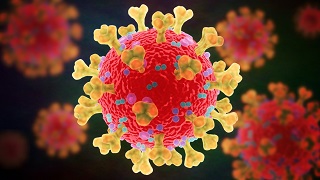University Of Bristol Study Discovers That Neuropilin-1 Is A Host Factor For SARS-CoV-2 Infectivity Involving The ESCPE-1 Endosomal Sorting Pathway
Source: NRP1-SARS-CoV-2 Jan 27, 2022 3 years, 5 months, 1 week, 19 hours, 5 minutes ago
NRP1-SARS-CoV-2: A new study by researchers from University of Bristol-UK along with experts from the University of Queensland-Australia and the University of Tartu-Estonia has found that Neuropilin-1 (NRP1) is also a host factor for SARS-CoV-2 infectivity involving the ESCPE-1 endosomal sorting pathway.

Endosomal sorting is a process that maintains cellular homeostasis by recycling transmembrane proteins and associated proteins and lipids (termed ‘cargoes’) from the endosomal network to multiple subcellular destinations, including retrograde traffic to the trans-Golgi network (TGN).
It has been known that viral and bacterial pathogens subvert retrograde trafficking machinery to facilitate infectivity.
The
NRP1-SARS-CoV-2 study team developed a proteomic screen to identify novel retrograde cargo proteins of the Endosomal SNX-BAR Sorting Complex Promoting Exit-1 (ESCPE-1).
Utilizing this methodology, the study team identify Neuropilin-1 (NRP1), a recently characterized host factor for SARS-CoV-2 infection, as a cargo directly bound and trafficked by ESCPE-1. ESCPE-1 mediates retrograde trafficking of engineered nanoparticles functionalized with the NRP1-interacting peptide of the SARS-CoV-2 Spike protein. ESCPE-1 sorting of NRP1 may therefore play a role in the intracellular membrane trafficking of NRP1-interacting viruses such as SARS-CoV-2.
The study findings were published on a preprint serve and are currently being peer reviewed.
https://www.biorxiv.org/content/10.1101/2022.01.20.477115v1
Typically, retrograde trafficking from endosomes to TGN protects integral proteins by diverting them from lysosomal degradation to ensure other cellular functions, but this transport pathway is exploited by multiple bacterial and viral pathogens to facilitate their infectivity.
Though the scientific community has made great leaps to understand the transport process aided by advances in research methodologies, the mechanistic basis of sorting and the cargoes trafficked via this pathway remain unknown.
ESCPE-1 is an endosomal coat complex protein involved in the retrograde transport of transmembrane proteins like the cation-independent mannose-6-phosphate receptor (CI-MPR).
ESCPE-1 is made of heterodimers of functionally redundant sorting nexins (SNXs), i.e., SNX1 or SNX2 associated with SNX5 or SNX6, and facilitates binding to cytosolic domains of transmembrane protein cargoes.
Neuropilin-1 or NRP1 acts as a coreceptor for several extracellular ligands, and recent reports suggest that it serves as a host factor for SARS-CoV-2 promoting the infection.
The study team screened the TGN proteome to find novel (retrograde) cargo proteins of the ESCPE-1 by developing a peroxidase-based proximity biotinylation method.
The team fused horseradish peroxidase (HRP) to the luminal terminus of TGN46, a single-pass type I transmembrane protein that localizes to TGN predominantly.
Simply incubating HRP-TGN46 in biotin-phenol (BP), a membrane-permeable precursor, and addi
ng hydrogen peroxide (H2O2) briefly for about a minute produces membrane-impermeable biotin-phenoxy radicals. These short-lived biotin-phenoxy radicals cause irreversible biotinylation of vicinal proteins and the luminal domains of transmembrane proteins.
The study findings confirmed biotinylation in a stable HeLa cell line expressing HRP-TGN46 by light and electron microscopy, fluorescent streptavidin staining, and the oxidative polymerization of 3,3'-diaminobenzidine (DAB).
Using stable isotope labeling of amino acids in cell culture (SILAC)-based quantitative proteomics, biotinylation was compared between scramble siRNA-treated and double SNX5+SNX6 siRNA-treated HeLa cells, and the study team found that the retrograde transport of TGN46 was independent of ESCPE-1, while double knockdown of SNX5 and SNX6 had no perturbing effects.
Neuropilin-1 or NRP1 was identified from a cluster of proteins after a STRING analysis that generated a network of protein-protein interactions (PPIs). An extracellular or luminal label of green fluorescent protein (GFP) was tagged to Nrp1 (GFP-Nrp1) and was tracked following endocytosis from the cell surface to subcellular compartments.
The study team observed changes in the colocalization of GFP-Nrp1 at different time points, i.e., with SNX6-positive endosomes in the early phase and TGN46 at later timepoints. This was repeated in double knockdown (SNX5+SNX6) HeLa cells which showed a lower rate of colocalization with TGN46.
Cycloheximide (CHX)-based blocking of protein synthesis revealed an elevated rate of endogenous NRP1 turnover in the double knockdown cells and no significant changes in the initial endocytic transport of GFP-Nrp1.
GFP-Nrp1 and mCherry-CI-MPR were coexpressed, and their trafficking was monitored, which showed their colocalization in the same tubule.
Based on a previous report of the association between the b1 domain of NRP1 and the multibasic C-terminal motif (C-end Rule or CendR motif) of S1 subunit of SARS-CoV-2 spike (S) protein, interactions between ESCPE-1 and S via NRP1 were investigated. S gene truncated at its C terminus, GFP-SNX5 and GFP-SNX6 were expressed in HEK293T cells followed by coimmunoprecipitation. It was observed that the S protein binding is mediated via an NRP1-dependent mechanism.
Subsequently, Silver (Ag) nanoparticles of the size of a coronavirion (80 nm) coated with SARS-CoV-2 S1's CendR peptide motif were engineered. It was found that the Ag-nanoparticles coated with the CendR motif were bound specifically to NRP1 at the surface of PPC1 cells that endocytose through an NRP1-dependent mechanism.
Furthermore, post-internalization, the CendR-coated silver nanoparticles transit towards the perinuclear region, colocalizing initially with VPS35 (vacuolar protein sorting ortholog 35) and later with CI-MPR and TGN46, which is found to be ESCPE-1-dependent because double knockdown PPC1 cells demonstrated a significant decrease in colocalization with TGN46.
The study findings reveal that NRP1 that was previously identified as a host factor for SARS-CoV-2 has now been demonstrated to be internally transported through an ESCPE-1-dependent mechanism to TGN. SARS-CoV-2 enters host cells in two ways: 1) direct fusion with the cell membrane and 2) endocytosis.
However, it remains to be studied if SARS-CoV-2 internalization could recruit NRP1- and ESCPE-1 dependent transport mechanisms to subvert innate cellular defenses.
The study findings expand the horizons of our understanding into the mechanisms of SARS-CoV-2 cell entry and other potential pathogens that can exploit NRP1 and ESCPE-1 to promote infectivity.
The confirmed involvement of NRP1 is also important as it can help explain numerous neurological involvement and manifestations in SARS-CoV-2 infections.
For the latest on
NRP1-SARS-CoV-2, keep on logging to Thailand Medical News.
